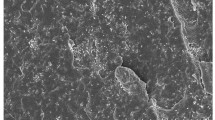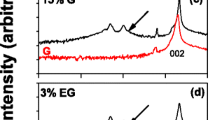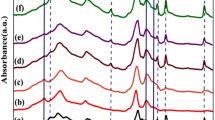Abstract
In this work, the crystal structure, thermal conductivity, as well as dielectric and electrical properties of poly(vinylidene fluoride-co-chlorotrifluoroethylene) [P(VDF-CTFE)] filled with two different carbon nanofillers including exfoliated graphite nanoplates (xGNPs) and multi-walled carbon nanotubes (MWCNTs) have been compared. The xGNPs and the MWCNTs were well dispersed in the P(VDF-CTFE) matrix using a simple solution-blending process. The xGNPs have the ability to induce the large amount of useful polar β and γ crystal phases for P(VDF-CTFE) via the relatively strong interfacial interaction between their functional groups and the dipoles of P(VDF-CTFE), while the MWCNTs only produce the relatively low amount of β crystal phases for P(VDF-CTFE) due to their weak π-dipole interactions with P(VDF-CTFE). It was found that both the electrical conductivity and dielectric properties of xGNPs/P(VDF-CTFE) composite were better than those of MWCNTs/P(VDF-CTFE) composite. The thermal conductivities of xGNPs/P(VDF-CTFE) composites were much higher when compared with those of MWCNTs/P(VDF-CTFE) composites at the same filler content, which is probably owing to the better compatibility between xGNPs and P(VDF-CTFE). For example, the thermal conductivities of xGNPs (5 wt%)/P(VDF-CTFE) composite and MWCNTs (5 wt%)/P(VDF-CTFE) composite were 0.83 W/mK and 0.43 W/mK, respectively.









Similar content being viewed by others
References
Nan CW, Shen Y, Ma J (2010) Physical properties of composites near percolation. Annu Rev Mater Res 40:131–151
Dang ZM, Zheng MS, Zha JW (2016) 1D/2D carbon nanomaterial-polymer dielectric composites with high permittivity for power energy storage applications. Small 12:1688–1701
Zhang K, Li G, Feng L, Wang N, Guo J, Sun K, Yu K, Zeng J, Li T, Guo Z, Wang M (2017) Ultralow percolation threshold and enhanced electromagnetic interference shielding in poly(L-lactide)/multi-walled carbon nanotubes nanocomposites with electrically conductive segregated networks. J Mater Chem C 36:9359–9369
Wan YJ, Yang WH, Yu SH, Sun R, Wong CP, Liao WH (2016) Covalent polymer functionalization of graphene for improved dielectric properties and thermal stability of epoxy composites. Compos Sci Technol 122:27–35
He FA, Lam KH, Ma D, Fan JT, Chan HLW, Zhang LM (2013) Fabrication and characterization of graphene–Fe3O4 hybrids and syndiotactic polystyrene/graphene–Fe3O4 nanocomposites. Carbon 58:175–184
Shi YD, Li J, Tan YJ, Chen YF, Wang M, Wu H, Guo S (2018) Low magnetic field-induced alignment of nickel particles in segregated poly(L-lactide)/poly(ε-caprolactone)/multi-walled carbon nanotube nanocomposites: towards remarkable and tunable conductive anisotropy. Chem Eng J 347:472–482
Liu YF, Feng LM, Chen YF, Shi YD, Chen XD, Wang M (2018) Segregated polypropylene/cross-linked poly(ethylene-co-1-octene)/multi-walled carbon nanotube nanocomposites with low percolation threshold and dominated negative temperature coefficient effect: towards electromagnetic interference shielding and thermistors. Compos Sci Technol 159:152–161
Tan YJ, Li J, Gao Y, Li J, Guo SY, Wang M (2018) A facile approach to fabricating silver-coated cotton fiber non-woven fabrics for ultrahigh electromagnetic interference shielding. Appl Surf Sci 458:236–244
Zhong SL, Zhou ZY, Zhang K, Shi YD, Chen YF, Oigiviy LF, Zeng JB, Wang M (2016) Formation of thermally conductive networks in isotactic polypropylene/hexagonal boron nitride composites via “bridge effect” of multi-wall carbon nanotubes and graphene nanoplatelets. RSC Adv 6:98571–98580
Zhang K, Yu HO, Yu KX, Gao Y, Wang M, Li J, Guo SY (2018) A facile approach to constructing efficiently segregated conductive networks in poly(lactic acid)/silver nanocomposites via silver plating on microfibers for electromagnetic interference shielding. Compos Sci Technol 156:136–143
Sun K, Xie P, Wang Z, Su T, Shao Q, Ryu J, Zhang X, Guo J, Shankar A, Li J, Fan R, Cao D, Guo Z (2017) Flexible polydimethylsiloxane/multi-walled carbon nanotubes membranous metacomposites with negative permittivity. Polymer 125:50–57
Chiu FC, Yeh SC (2015) Comparison of PVDF/MWNT, PMMA/MWNT, and PVDF/PMMA/MWNT nanocomposites: MWNT dispersibility and thermal and rheological properties. Polym Test 45:114–123
Wang M, Zhang K, Dai X, Li Y, Guo J, Liu H, Li G, Tan Y, Zeng J, Guo Z (2017) Enhanced electrical conductivity and piezoresistive sensing in multi-wall carbon nanotubes/polydimethylsiloxane nanocomposites by constructing a self-segregated structure. Nanoscale 9:11017–11026
He FA, Lam KH, Fan JT, Chan HLW (2013) Novel syndiotactic polystyrene/BaTiO3-graphite nanosheets three-phase composites with high dielectric permittivity. Polym Test 32:927–931
He FA, Lau ST, Chan HLW, Fan JT (2009) High dielectric permittivity and low percolation threshold in composites based on poly(vinylidene fluoride) and exfoliated graphite nanosheets. Adv Mater 21:710–715
He FA, Lam KH, Fan JT, Chan HLW (2014) Improved dielectric properties for chemically functionalized exfoliated graphite nanoplates/syndiotactic polystyrene composites prepared by a solution-blending method. Carbon 80:496–503
Neubauer EKM, Hulman M, Angerer P (2010) Potential and challenges of metal matrix-composites reinforced with carbon nanofibers and carbon nanotubes. Compos Sci Technol 70:2228–2236
Kuester S, Merlini C, Barra GMO, Ferreira JC, Lucas A, de Souza AC (2016) Processing and characterization of conductive composites based on poly(styrene-b-ethylene-ran-butylene-b-styrene) (SEBS) and carbon additives: a comparative study of expanded graphite and carbon black. Compos Part B Eng 84:236–247
Sullivan EM, Karimineghlani P, Naraghi M, Gerhardt RA, Kalaitzidou K (2016) The effect of nanofiller geometry and compounding method on polylactic acid nanocomposite films. Eur Polym J 77:31–42
Huang CL, Wang YJ, Fan YC, Hung CL, Liu YC (2017) The effect of geometric factor of carbon nanofillers on the electrical conductivity and electromagnetic interference shielding properties of poly(trimethylene terephthalate) composites: a comparative study. J Mater Sci 52:2560–2580. https://doi.org/10.1007/s10853-016-0549-5
Wojtas M, Karpinsky DV, Silibin MV, Gavrilov SA, Sysa AV, Nekludov SKN (2017) Dielectric properties of graphene oxide doped P(VDF-TrFE) films. Polym Test 60:326–332
He FA, Lin K, Shi DL, Wu HJ, Huang HK, Chen JJ, Chen F, Lam KH (2016) Preparation of organosilicate/PVDF composites with enhanced piezoelectricity and pyroelectricity by stretching. Compos Sci Technol 137:138–147
Martinsa P, Lopesa AC, Lanceros-Mendez S (2014) Electroactive phases of poly(vinylidene fluoride): determination, processing and applications. Prog Polym Sci 39:683–706
Zhang SH, Zhang NY, Huang C, Ren KL, Zhang QM (2005) Microstructure and electromechanical properties of carbon nanotube/poly(vinylidene fluoride-trifluoroethylene-chlorofluoroethylene) composites. Adv Mater 17:1801–1897
He FA, Kim MJ, Chen SM, Wu YS, Lam KH, Chan HKW, Fan JT (2017) Tough and porous piezoelectric P(VDF-TrFE)/organosilicate composite membrane. High Perform Polym 29:133–140
Garain S, Jana S, Sinha TK, Mandal D (2016) Design of in situ poled Ce3+-doped electrospun PVDF/graphene composite nanofibers for fabrication of nanopressure sensor and ultrasensitive acoustic nanogenerator. ACS Appl Mater Interfaces 8:4532–4540
Sinha TK, Ghosh SK, Maiti R, Jana S, Adhikari B, Mandal D, Ray SK (2016) Graphene-silver-induced self-polarized PVDF-based flexible plasmonic nanogenerator toward the realization for new class of self-powered optical sensor. ACS Appl Mater Interfaces 8:14986–14993
Yang L, Ji HL, Zhu KJ, Wang J, Qiu JH (2016) Dramatically improved piezoelectric properties of poly(vinylidene fluoride) composites by incorporating aligned TiO2@MWCNTs. Compos Sci Technol 123:259–267
Ameduri B (2009) From vinylidene fluoride (VDF) to the applications of VDF-containing polymers and copolymers: recent developments and future trends. Chem Rev 109:6632–6686
Li ZM, Wang YH, Cheng ZY (2006) Electromechanical properties of poly(vinylidene-fluoride-chlorotrifluoroethylene) copolymer. Appl Phys Lett 88:062904
Garain S, Sinha TK, Adhikary P, Henkel K, Sen S, Ram S (2015) Self-poled transparent and flexible UV light-emitting cerium complex-PVDF composite: a high-performance nanogenerator. ACS Appl Mater Interfaces 7:1298–1307
Tamang A, Ghosh KS, Garain S, Alam MM, Haeberle J, Henkel K (2015) DNA-assisted β phase nucleation and alignment of molecular dipoles in PVDF Film: a realization of self-Poled bioinspired flexible polymer nanogenerator for portable electronic devices. ACS Appl Mater Interfaces 7:16143–16147
Bidsorkhia HC, D’Aloiaa AG, Bellisa GD, Proiettia A, Rinaldia A, Fortunato M (2017) Nucleation effect of unmodified graphene nanoplatelets on PVDF/GNP film composites. Mater Today Commun 11:163–173
Tiwari VK, Prasad AK, Singh V, Jana KK, Misra M, Prasad CD (2013) Nanoparticle and process induced super toughened piezoelectric hybrid materials: the effect of stretching on filled system. Macromolecules 46:5595–5603
Salimi A, Yousefi AA (2003) FTIR studies of β-phase crystal formation in stretched PVDF films. Polym Test 22:699–704
Yu SS, Zheng WT, Yu WX, Zhang YJ, Jiang Q, Zhao ZD (2009) Formation mechanism of β-phase in PVDF/CNT composite prepared by the sonication method. Macromolecules 42:8870–8874
Martins P, Caparros C, Gonçalves R, Martins PM, Benelmekki M, Botelho G (2012) Role of nanoparticle surface charge on the nucleation of the electroactive β-poly(vinylidene fluoride) nanocomposites for sensor and actuator applications. J Phys Chem C 116:15790–15794
Achaby ME, Arrakhiza FZ, Vaudreuila S, Essassia EM, Qaissa A (2012) Piezoelectric β-polymorph formation and properties enhancement in graphene oxide–PVDF nanocomposite films. Appl Surf Sci 258:6777–7668
Ray SS (2013) Rheological properties of environmentally friendly polymer nanocomposites (EFPNCs) using biodegradable polymer matrices and clay/carbon nanotube (CNT) reinforcements. In: Environmentally friendly polymer nanocomposites. Woodhead Publishing, pp 450–464. https://doi.org/10.1533/9780857097828.2.450
Yuan JK, Li LW, Yao SH, Lin YQ, Bai JB (2011) High dielectric permittivity and low percolation threshold in polymer composites based on SiC-carbon nanotubes micro/nanohybrid. Appl Phys Lett 98:032901
Dang ZM, Wang L, Yin Y, Zhang Q, Lei QQ (2007) Giant dielectric permittivities in functionalized carbon-nanotube/electroactive-polymer composites. Adv Mater 19:852–857
Xie LY, Huang XY, Wu C, Jiang PK (2011) Core-shell structured poly(methyl methacrylate)/BaTiO3 nanocomposites prepared by in situ atom transfer radical polymerization: a route to high dielectric constant materials with the inherent low loss of the base polymer. J Mater Chem 21:5897–5906
Gangulia S, Roya AK, Anderson DP (2010) Thermal conductivity of platelet-filled polymer composites. J Am Ceram Soc 85:851–857
Zhou WY, Zou J, Ren WN (2012) Thermal conductivity and dielectric properties of Al/PVDF composites. Compos Part A Appl Sci Manuf 43:658–664
Zhou WY, Qi S, Li H, Shao S (2007) Study on insulating thermal conductive BN/HDPE composites. Thermochim Acta 245:36–42
Zhang S, Ke YC, Cao XY, Ma YM, Wang FS (2012) Effect of Al2O3 fibers on the thermal conductivity and mechanical properties of high density polyethylene with the absence and presence of compatibilizer. J Appl Polym Sci 124:4874–4881
Gangulia S, Roya AK, Anderson DP (2008) Improved thermal conductivity for chemically functionalized exfoliated graphite/epoxy composites. Carbon 46:806–817
Ahn KS, Kim KH, Kim JH (2015) Thermal conductivity and electric properties of epoxy composites filled with TiO2-coated copper nanowire. Polymer 76:313–320
Hwang YS, Ahn KS, Kim JH (2014) Silicon carbonitride covered SiC composites for enhanced thermal conductivity and electrical insulation. Appl Therm Eng 270:600–608
Min C, Yu DM, Cao JY, Wang GL, Feng LH (2013) A graphite nanoplatelet/epoxy composite with high dielectric constant and high thermal conductivity. Carbon 55:116–125
Teng CC, Ma CCM, Lu CH, Yang SY, Lee SH, Hsiao MC (2011) Thermal conductivity and structure of non-covalent functionalized graphene/epoxy composites. Carbon 49:5107–5116
Agari Y, Ueda A, Naca S (1991) Thermal conductivities of composites in several types of dispersion systems. J Appl Polym Sci 42:1665–1669
Zhang XL, Shen LY, Wu H, Guo SY (2013) Enhanced thermally conductivity and mechanical properties of polyethylene (PE)/boron nitride (BN) composites through multistage stretching extrusion. Compos Sci Technol 89:24–28
He H, Fu RL, Shen Y, Han YC, Song XF (2007) Preparation and properties of Si3N4/PS composites used for electronic packaging. Compos Sci Technol 267:2493–2499
Acknowledgements
The authors would like to acknowledge the support of the Guangdong Province Natural Science Foundation, China (Nos. 2017A030313268 and 2017A030313080), the Guangdong Province Natural Science Foundation for Distinguished Young Scientists, China (No. S2013050014139), and the Hong Kong Polytechnic University (1-ZVGH, G-YBLM, and G-YBPN).
Author information
Authors and Affiliations
Corresponding authors
Ethics declarations
Conflict of interest
We declare that we do not have any commercial or associative interest that represents a conflict of interest in connection with the work submitted.
Rights and permissions
About this article
Cite this article
Lin, B., Pan, LH., Shi, DL. et al. Preparation and characterization of composites based on poly(vinylidene fluoride-co-chlorotrifluoroethylene) and carbon nanofillers: a comparative study of exfoliated graphite nanoplates and multi-walled carbon nanotubes. J Mater Sci 54, 2256–2270 (2019). https://doi.org/10.1007/s10853-018-3005-x
Received:
Accepted:
Published:
Issue Date:
DOI: https://doi.org/10.1007/s10853-018-3005-x




